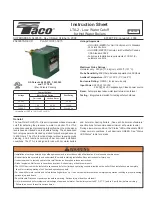
33
Installing a Vent
Vent Pipe Materials
Caution
Use of cellular core PVC (ASTM F891), cellular core CPVC, or
Radel® (polyphenylsulfone) in no-nmetallic venting systems
is prohibited. Covering non-metallic vent fttings with thermal
insulation is prohibited.
Venting requirements difer in the USA and Canada. Consult the
following chart or the most recent edition of ANSI Z223.1/NFPA
54 or CAN/CGA B149.1, as well as all applicable local codes and
regulations when selecting vent pipe materials. Do not use cellular
core-based pipe materials for the exhaust vent.
Locale
Recommended Vent Materials
USA
•
PVC Schedule 40 (solid core)
•
CPVC Schedule 40 or 80 (solid core)
•
Approved Polypropylene
Canada*
•
Type BH Special Gas Vent Class IIA (PVC)
•
Type BH Special Gas Vent Class IIB (CPVC)
•
Thpe BH Special Gas Vent Class IIC (Polypropylene)
* For installation in Canada, fIeld-supplied plastic vent piping must comply with
CAN/CGA B149.1 (latest edition) and be certified to the Standard For Type BH
Gas Venting Systems, ULC-S636. Components of this listed system must not be
interchanged with other vent systems or unlisted pipes or fttings. All plastic
components and specified primers and glues of the certified vent system
must be from a single system manufacturer and must not be intermixed with
another system manufacturer’s parts. The supplied vent connector and vent
termination are certifIed as part of the boiler.
Caution
•
This boiler has a built-in control to limit the exhaust
temperature to 158°F (70°C). As a result, the VESTA.DS boiler
can be vented with Schedule 40 PVC.
•
In high temperature applications, the exhaust temperature
can exceed 149°F (65°C). In that case, you must use
Schedule 40 or 80 CPVC or Approved Polypropylene in the
USA or Type BH Special Gas Vent Class IIB (CPVC) or Class IC
(Polypropylene) that conforms to ULC-S636 in Canada.
•
Generally, the boiler limits the flue gas to remain below 150°F
(65°C) to use the flue pipe.
•
When the return water temperature to the boiler is higher than
140°F (60°C), DIP switch #1 must be set to ON to release the flue
gas limit. CPVC or PP must be used in such case.
Notice
•
PCB DIP switch #1 is set to OFF as factory default
•
When you set PCB DIP switch #1 to ON, ensure that CPVC piping shall
be used for exhaust venting.
1 2 3 4 5 6 7 8
ON
Vent Length
The maximum vent length when using 2" exhaust ducts is 60’. The
maximum vent length when using 3" vent ducts is 150’. The intake
duct length can be of equal length to the exhaust duct length. Both
maximum lengths are reduced by the number of elbows used, as
shown in the following table:
Vent
Size
Maximum
Length
Maximum
# of
Elbows
Equivalent Lengths
2"
60' (18 m)
6
Reduce the maximum vent
length accordingly for each
elbow used:
•
Each 90° elbow equates
to 8 linear feet (2.4 m)
of vent
•
Each 45° elbow equates
to 4 linear feet (1.2 m)
of vent
3"
150' (45 m)
8
Reduce the maximum vent
length accordingly for each
elbow used:
•
Each 90° elbow equates
to 5 linear feet (1.5 m)
of vent
•
Each 45° elbow equates
to 3 linear feet (0.9 m)
of vent
Notice
•
The maximum length does not include any elbows.
•
If using a concentric termination as shown on pages 33, count this as
8 linear feet (2.4 m) of vent.
Содержание VRC-100
Страница 62: ...Memo ...
Страница 63: ...Memo ...
















































